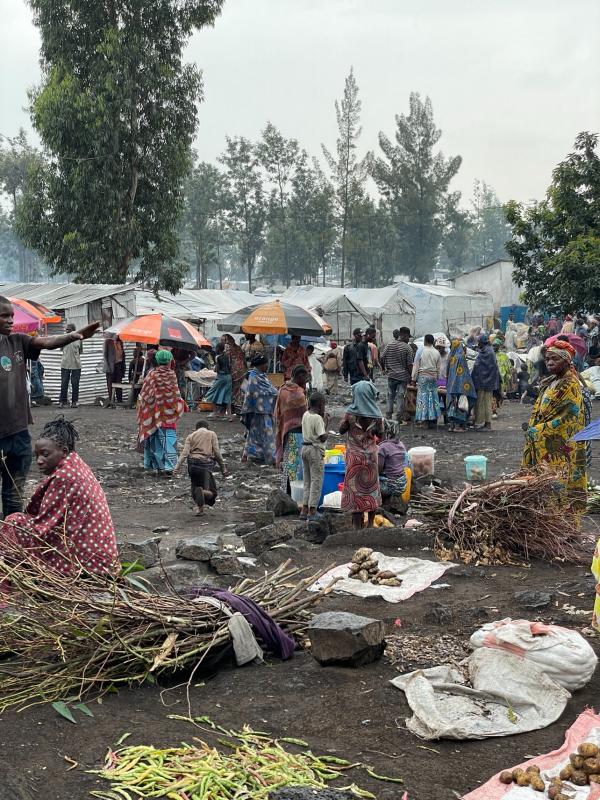Resurgence of Violence in Eastern DRC increases risk of epidemics in the Kivus
Photo: Joachim Giaminardi / Norwegian Refugee Counncil
29 Mar 2024 by The Water Diplomat

A resurgence of violence on the border between North and South Kivu in the Democratic Republic of Congo has led to a large new wave of internally displaced people arriving in Goma in need of humanitarian assistance. In its press release on the 22nd of March, the Executive Director of the World Food Programme Cindy McCain stated: “The city of Goma - in itself located between lake Kivu and the border with Rwanda - is surrounded by tens of thousands of temporary shelters, and the numbers are growing every single day. The displaced people crammed into them urgently require food, clean water and sanitation. WFP needs the support of donors and partners to step up our response to this worsening crisis and provide badly needed assistance to people living in the camps before it’s too late.” Doctors without Borders is reporting an increase in the risk of epidemics in the refugee camps, especially of cholera, as a result of the critical health situation and urgent needs in the camps.
Since January, the population in the displacement camps in the outskirts of Goma has almost doubled. The nutritional and health conditions of the population arriving in the camps is deplorable. The number of severely malnourished children under 5 years old admitted by Action Against Hunger in Lushagala camp 1 and 2 has multiplied by four since November 2023. In February, ACF received up to 10 new cases per day of children in severe acute malnutrition. Malnutrition, in turn, weakens the body’s capacity to respond to diseases, increasing the vulnerability of the displaced populations.
According to the Norwegian Refugee Council, the advance of armed groups towards the town of Sake, located to the north-west of Goma, which is a key link between Goma and the rest of the country, poses a threat to the entire aid system in the region. According to Joachim Giaminardi from the Norwegian Refugee Council, the road north to Rutshuru has been blocked since November 2023 when the ceasefire fell apart. Similarly, another road to Mwesu has been closed since November, and since that time the fighting has moved towards Sake, which has cut off supplies to Goma from the DRC side. About eleven informal settlements sites have sprung up on the road between Sake and Goma in which about 400,000 people are currently located
Goma is already home to more than 2 million people and an additional half million internally displaced persons. The displaced persons are living in extreme conditions as most people are located in overcrowded locations with a lack of land for settlement and insufficient shelter. An assessment carried out several weeks ago in informal settlements indicated that on average, each individual has access to no more than 3.8 litres of water a day.
Across the Democratic Republic of Congo, according to a 2024 humanitarian needs assessment , it is estimated that some 6,9 million people are in need of humanitarian assistance in the area of water and sanitation, of which the majority are located in North and South Kivu.
In less than 10 days, more than 250,000 people have fled the conflict area and are seeking shelter with host families and in pre-existing, unofficial displacement sites to the west of Goma. In these sites, families are crowded into makeshift shelters that offer little to no protection from the rain. Medical staff are apprehensive that with the influx of new people into the region in combination with limited supplies of safely managed water are creating the conditions for a surge in the cholera cases that they have signaled. The International Committee of the Red Cross reports that more than 39,000 people have sought refuge in Kanyabayonga in the northern part of north Kivu. An earlier report by Oxfam from late February made mention of 133,000 people who had fled the violence in north Kivu and were living in very difficult conditions without a single toilet or safe water source. The same report mentions that host communities are charging U.S. $ 0.40 for the use of a toilet or shower, and that women have to walk up to 25 kilometres to fetch water, exposing them to violence from armed groups. The water supply situation is difficult as the area overlies layers of volcanic rock and therefore access to groundwater is limited. Nevertheless, UNICEF built a supplementary water supply pipeline to extend the municipal network and provide water to an estimated 150,000 displaced individuals. This has replaced the expensive water trucking to sites such as Bushagara and Kanyaruchinya.
